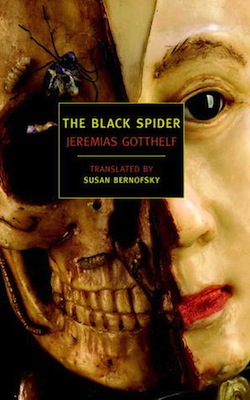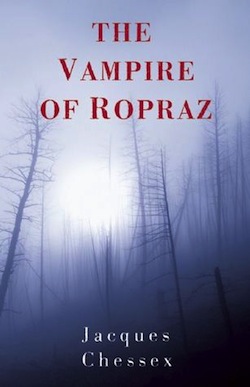Book Review: Two Volumes of Swiss Horror for Halloween
Half of Switzerland is Hell, but the other half is Paradise. – Voltaire
The Vampire of Ropraz, by Jacques Chessex. Translated from the French by W. Donald Wilson. 106 pages, Bitter Lemon Press. $!2.95.
The Black Spider, by Jeremias Gotthelf. Translated from the German by H. M. Waidson. Oneworld Classics. 128 pages, $14.95.
The Black Spider, by Jeremias Gotthelf. Translated from the German by Susan Bernofsky. New York Review Books, 108 pages, $12.95.
By Bill Marx
Though separated by a century and a half, these two Swiss novellas detailing uncanny terror in rural communities suggest that the percentage of the demonic in Switzerland has grown considerably since Voltaire made his observation about the equality of good and evil.
The Vampire of Ropraz offers a sort of sociological/political analysis of horror. Faced with acts of irrational violence, miasmic forces of ignorance and fear in the community inevitably dominate. The classic The Black Spider, first published in 1842 (Oneworld Classics reprints a 1958 English edition; The New York Review of Books is publishing a spanking new translation) revolves around a reneged deal with the Devil, who wants, but doesn’t get, an unbaptized child as payment for his services at the behest of the beleaguered working classes. The betrayal unleashes the title demon, who can be stopped by goodness, if it is free of moral corruption and hypocrisy. Locating virtue turns out to be a tall order. But at least there’s some Paradise around to counterbalance Gotthelf’s Hell.
Interestingly, both of these books root their avenging vision of mayhem in the brutal mistreatment of children. Gotthelf appears to wish for a God “Who would avenge Himself terribly for all the injustice that is done to poor children who cannot defend themselves.” In an ironic way, the Devil is doing the Lord’s work by punishing the sadists among the low- and upper classes. The suspected “vampire” in Chessex’s volume, which is based on a true story, was treated so horribly as a child he is barely human. Among the few who offer him kindness is a psychologist who sees the man as “more a victim of rural poverty than the tormentor of a society unwilling to allow him a chance in life.”
The differences between these two tales of violence, besides their metaphysics, turn on issues of scale and writing style. Chessex, who won the Prix Goncourt for his 1974 novel The Ogre, approaches his tale of enigmatic violation in a distinctly doc-u-drama manner. His prose style is clinical and tersely poetic. The plot is primal: in a turn-of-the century village high in the Swiss mountains the graves of three young women are pillaged: their bodies have been dug up and left heinously mutilated in the snow. (Be warned: the damage to the corpses is exactingly detailed.) The population demands that the “vampire,” as the creature is called in the press, be caught and destroyed. Preachers decry the general immorality; garlic and crucifixes are worn by many for protection, all to ward off “the obsession with sexual, expiatory violation engrafted in the flesh. The ancient guilt of bodies punished, offered to the Devil.”
A stable boy named Charles Fevez is arrested and, despite scarce evidence, quickly convicted. After undergoing psychiatric observation he vanishes: years later Fevez turns up, according to Chessex, fighting in World War I. The author’s sublimated fury blames religion, isolation, and sexual repression for the provinical village’s ungodly misery: “In this remote countryside a young girl is a lodestar for lunacy. For incest and brooding in unwed gloom on flesh forever desired and forever forbidden.” Anchored in repression and frustration, it’s no wonder the forces of sanity are impotent.
The narrative’s serenely hands-off approach can be frustrating at times: readers are kept a safe distance from the goings-on in Fevez’s mind. But The Vampire of Ropraz proffers a lyrically compacted image of the ugly fruits of a collective psychopathology, a bitterly sharp critique of frightened people who know that “the monster will have the last word in this vale of bitter tears and richly deserved darkness that God has granted us.”
A Swiss pastor, Gotthelf serves up a far more complex yarn of God’s mysterious grace, his ferocious fairy tale offering scenes of gore and scorched earth worthy of a Hollywood horror film. A tyrannical landowner demands the exhausted villagers (who just built him a castle) do a herculean job of tree planting. The Devil offers to do the task, if he gets an unbaptized child in payment. He is rebuffed at first, but then Christine (a woman from another country; there’s a strain of xenophobia in the story) takes up the offer. Once the Devil has done his part he waits for the first unchristened child, only to be “outsmarted” when the kid baptized in record time.
Thus a rein of terror of plague-like upheaval begins, with thousands of lethal black spiders spreading across the countryside, killing livestock, men, women, and children. The first batch of homicidal bugs pop out of the cheek of the woman who made the agreement:
Then Christine felt as if her face was bursting open, as if burning coals were being born, coming to life and crawling away over her face, over all her limbs as if her whole face was coming to life and crawling away red-hot over all her body. In the pale light from the lightning she now saw black little spiders, long-legged, poisonous and innumerable, running over her limbs and out into the night … (H. M. Waidson translation)
And then Christine felt as if her face was bursting open, and flowing coals were being birthed from it, quickening into life and swarming across her face and all her limbs, and everything within her face had sprung into life, a fiery swarming all across her body. In the lightening’s pallid glow she saw, long-legged and venomous, innumerable black spiderlings scurrying down her limbs and out into the night, and as they vanished they were followed, long-legged and venomous, by innumerable others. (Susan Bernofsky translation)
Amazing stuff, and the giant black spider that perches on people’s heads is yet to come! (The macabre images of creepy crawlies pouring out of a human face probably inspired similar scenes in The Believers, John Schlesinger’s 1997 film about voodoo.) Gotthelf tries to defuse the power of his apocalyptic imagination by nesting these nightmares in a reassuring framing tale. But the oh-so-idyllic description of the christening of a child ends up playing the same role as the sugar-glazed hysteria in the opening of David Lynch’s Blue Velvet. Things are too desperately perfect; in retrospect, the fear of unspeakable evil redux transforms ceremony into fetish, a highly controlled attempt to charm away disaster. The godmother’s crippling fear of not remembering the name of the child during the ceremony is the mischievous giveaway. There is a fascinating linguistic subtext to The Black Spider — the sacralization of a child’s name stands as a razor thin dividing line between safety and nightmare.
The translation by H. M. Waidson creaks and lumbers when it should explode, though the volume offers an informative enough introduction. Bernofsky’s version, unlike most in the NYRB lineup, doesn’t have an intro. And the misleading flap copy compares Gotthelf’s vision of “cosmic horror” to that of H.P. Lovecraft’s. But the former’s memorably infernal insects, rooted in folk supernaturalism, have little in common with the dime store gore brigade led by Cthulhu (described by critic Edmund Wilson as “a giant whistling octopus”) that populates Lovecraft’s purple-to-the-max prose. Still, Bernofksy’s translation contains plenty of CGI snap and crackle, as you can tell in the quotation above — love the “spiderlings,” though her repetition of “innumerable” and “venomous” is (Lovecraft-inspired?) overkill.
Thomas Mann may have gone overboard by admiring The Black Spider “like almost no other piece of world literature” – but it’s a sensational yarn of sin and salvation that still delivers a wonderfully cankered sting.
Tagged: Jacques Chessex, Jeremias Gotthelf, The Black Spider



